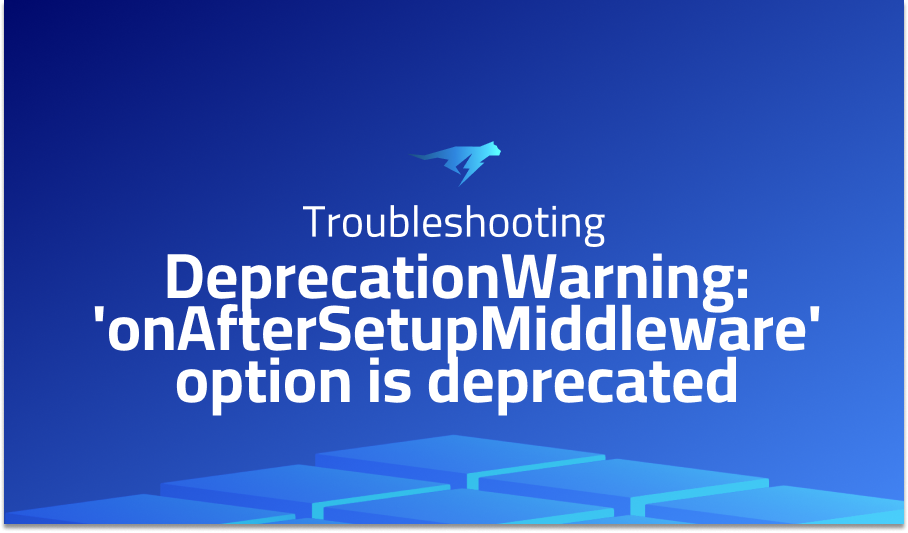

DeprecationWarning: ‘onAfterSetupMiddleware’ option is deprecated
Explanation of the problem
When running npm start, a deprecation warning is displayed in the console regarding the usage of the onAfterSetupMiddleware and onBeforeSetupMiddleware options in the webpack-dev-server configuration. These options are no longer supported and have been replaced by the setupMiddlewares option. This warning indicates that the project is using an outdated configuration for the webpack-dev-server and needs to be updated to avoid potential issues in future versions.
To resolve this warning, update the configuration of webpack-dev-server in the project’s webpack.config.js file by replacing the deprecated onAfterSetupMiddleware and onBeforeSetupMiddleware options with the setupMiddlewares option. The setupMiddlewares option provides a more flexible and modular approach to configuring the middleware stack of the webpack-dev-server.
Here’s an example of how to update the configuration:
module.exports = {
// ...
devServer: {
setupMiddlewares: [
// Add your middleware configuration here
]
}
};
With this updated configuration, the deprecation warning should no longer appear when running npm start. It is recommended to keep the webpack-dev-server configuration up-to-date to avoid compatibility issues with future versions of the tool.
Troubleshooting with the Lightrun Developer Observability Platform
Getting a sense of what’s actually happening inside a live application is a frustrating experience, one that relies mostly on querying and observing whatever logs were written during development.
Lightrun is a Developer Observability Platform, allowing developers to add telemetry to live applications in real-time, on-demand, and right from the IDE.
- Instantly add logs to, set metrics in, and take snapshots of live applications
- Insights delivered straight to your IDE or CLI
- Works where you do: dev, QA, staging, CI/CD, and production
Start for free today
Problem solution for DeprecationWarning: ‘onAfterSetupMiddleware’ option is deprecated
The warning that is being reported here is related to the deprecation of the onAfterSetupMiddleware and onBeforeSetupMiddleware options in webpack-dev-server. These options were used to add middleware to the webpack-dev-server instance before and after the server had started respectively. However, they have been deprecated in favor of the setupMiddlewares option, which allows users to add middleware in a more flexible manner.
To solve this issue, you need to update the configuration of the webpack-dev-server instance in your project to use the setupMiddlewares option instead of the deprecated onAfterSetupMiddleware and onBeforeSetupMiddleware options. This can be achieved by modifying the configuration file of your webpack-dev-server instance, typically found in webpack.config.js or webpack.dev.js.
Here is an example of how to modify the webpack-dev-server configuration file to use the setupMiddlewares option:
module.exports = {
// ...
devServer: {
setupMiddlewares: (devServer) => {
// Add middleware here
},
},
};
If you still see the warning even after modifying the configuration, you can use the --trace-deprecation flag when running your project to get more information about where the warning was created. This can help you identify any remaining uses of the deprecated options in your code and update them accordingly.
It’s also worth noting that some users have reported that this warning disappears after repairing their installation of Node.js. This may be an option to consider if updating your webpack-dev-server configuration doesn’t work. To repair your installation of Node.js, you can use the following command:
npm install -g node-gyp
node-gyp configure
node-gyp build
This will rebuild any missing or outdated dependencies in your Node.js installation and may resolve the warning you’re seeing. However, it’s important to note that this solution is not directly related to the warning itself and may not be effective in all cases.
Other popular problems with React
Problem: Virtual DOM performance issues
One of the most common problems with React is related to performance issues with the virtual DOM. The virtual DOM is a mechanism that React uses to update the view in response to changes in the underlying data. When the state of a component changes, React will first update the virtual DOM, and then update the actual DOM. This process can be slow, particularly if the component has a large number of child elements.
Solution:
To solve this problem, developers can use techniques such as shouldComponentUpdate, which allows components to control when they should re-render, or use the React.memo higher-order component, which only re-renders a component when its props change. Additionally, developers can use the React DevTools extension to identify and optimize components that are causing performance bottlenecks.
Problem: Managing state and props
Another common problem with React is related to managing state and props. React components can have both state and props, which are used to store and pass data between components. However, when a large number of components need to share and update data, it can become difficult to manage and maintain the flow of data.
Solution:
To solve this problem, developers can use a centralized state management library such as Redux or MobX. These libraries allow developers to store all of the application’s state in a single place, and provide a mechanism for updating and sharing that state across all components. Additionally, developers can use the useContext and useReducer hooks to manage state within a component tree.
Problem: Handling Forms
React forms can also be a source of pain for developers, as they require a lot of boilerplate code to handle changes and validation. Forms can be tricky to handle because they often involve multiple inputs, which need to be controlled and updated correctly.
Solution:
To solve this problem, developers can use libraries such as Formik and react-hook-form to handle forms in React. These libraries provide simple APIs for controlling form inputs and handling validation. Additionally, developers can use the useState and useEffect hooks to handle form input changes and validation manually.
A brief introduction to React
React is a JavaScript library for building user interfaces. It was developed by Facebook and is now maintained by a community of developers. React allows developers to build reusable UI components, which can be composed to create complex user interfaces. React uses a virtual DOM (Document Object Model) to improve performance by limiting the amount of changes that need to be made to the actual DOM. The virtual DOM is a lightweight representation of the actual DOM and it allows React to compare the current state of the virtual DOM with the previous state, and make only the necessary changes to the actual DOM.
React follows a component-based architecture, where the user interface is broken down into small, self-contained components that can be easily reused and composed to create more complex UI. React components can have both state and props, which are used to store and pass data between components. React also provides a mechanism for handling events, such as user clicks, through the use of event handlers. React also provides a set of lifecycle methods that developers can use to control when a component is created, updated, and destroyed. This allows developers to control the behavior of their components and optimize performance.
Most popular use cases for React
- Building reusable UI components React allows developers to build reusable UI components that can be composed to create complex user interfaces. Each component is self-contained and can manage its own state and props. This allows developers to easily reuse and maintain their code.
- Dynamic User Interfaces React uses a virtual DOM to improve performance by limiting the amount of changes that need to be made to the actual DOM. This allows developers to build dynamic user interfaces that can efficiently update in response to changes in the underlying data.
- Building complex web applications React can be used to build complex web applications that require efficient updating of dynamic data. React also provides a set of lifecycle methods that developers can use to control when a component is created, updated, and destroyed. This allows developers to control the behavior of their components and optimize performance.
class Counter extends React.Component {
constructor(props) {
super(props);
this.state = { count: 0 };
}
handleClick = () => {
this.setState({ count: this.state.count + 1 });
}
render() {
return (
<div>
<p>Count: {this.state.count}</p>
<button onClick={this.handleClick}>
Increment
</button>
</div>
);
}
}
It’s Really not that Complicated.
You can actually understand what’s going on inside your live applications.




